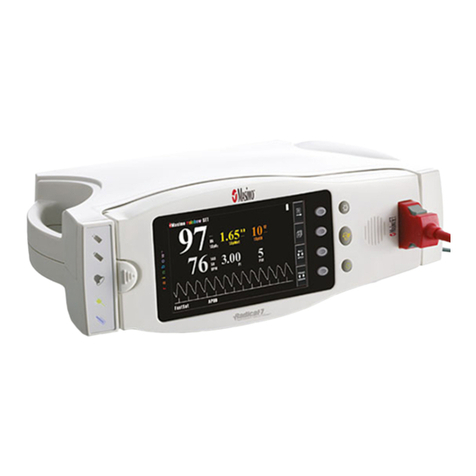
Rad-57 Signal Extraction Pulse CO-Oximeter Operator’s Manual
vi
Table of Contents
Pleth Variability Index - PVI (upgraded Instrument)..............................................................4-8
Low Signal IQ (Low SIQ) ......................................................................................................4-8
Low Perfusion........................................................................................................................4-8
Actions to be Taken..............................................................................................................4-9
Sensitivity ..............................................................................................................................4-9
Battery Level Indicator ........................................................................................................4-10
Low Battery Audible Alarm ..................................................................................................4-10
Normal Patient Monitoring .........................................................................................................4-11
Rad-57 Front Panel Control Operation ............................................................................... 4-11
Setup Menu ...............................................................................................................................4-11
Menu Navigation ................................................................................................................. 4-11
Setup Menu Level 1 – Alarm Volume and Alarm Silence ...................................................4-12
Setup Menu Level 2 – Alarm Limits ....................................................................................4-12
Setup Menu Level 3 – Sensitivity, Averaging, FastSat, SmartTone....................................4-13
Setup Menu Level 4 - Trend Settings .................................................................................4-14
Setup Menu Level 5 - LED Brightness and Factory Defaults .............................................4-15
Menu Selection....................................................................................................................4-15
Power Off ............................................................................................................................4-15
Special Menu ............................................................................................................................ 4-16
Special Menu – Line Frequency Configuration...................................................................4-16
Trend Setup and Use................................................................................................................ 4-17
Introduction..........................................................................................................................4-17
TrendCom Utility Installation ...............................................................................................4-17
Erasing Trend Memory........................................................................................................4-17
Trend Data Format..............................................................................................................4-17
SECTION 5 - ALARMS AND MESSAGES
Alarm Indication .......................................................................................................................... 5-1
Alarm Limits ................................................................................................................................ 5-1
Alarm Silence ........................................................................................................................5-3
Alarm Silenced Indicator .......................................................................................................5-3
Messages..............................................................................................................................5-4
SECTION 6 - TROUBLESHOOTING
Troubleshooting .......................................................................................................................... 6-1
SECTION 7 - SPECIFICATIONS
Rad-57 Specifications................................................................................................................. 7-1
Performance..........................................................................................................................7-1
Electrical................................................................................................................................7-2
Environmental .......................................................................................................................7-2
Physical Characteristics ........................................................................................................7-2
SECTION 8 - SENSOR AND PATIENT CABLES
Introduction ................................................................................................................................. 8-1
Selecting a Sensor................................................................................................................8-1
Sensor Application Instructions .............................................................................................8-1
Masimo Rainbow®Sensors..................................................................................................8-2
Rainbow R Series Adhesive Sensors ...................................................................................8-2




























